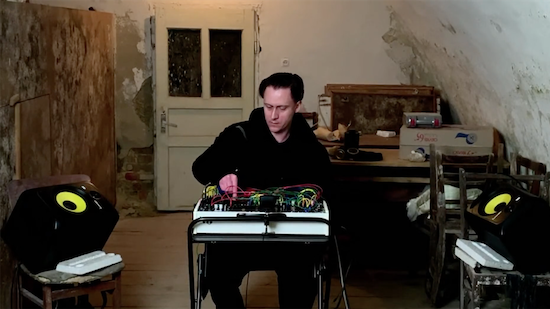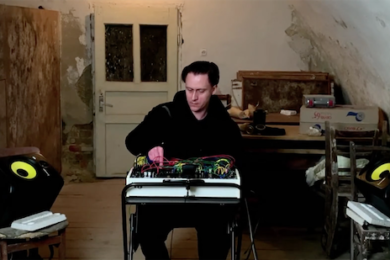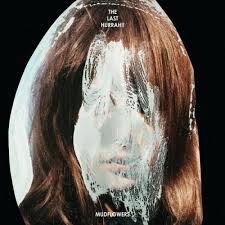Heinali performs live from a bomb shelter in Ukraine
On 24 February, russia invaded Ukraine beyond the territories of Crimea and Donbas, which have been occupied since 2014. What seemed unimaginable to many started happening right in front of our eyes. Scenes that took place in Bucha, Irpin, or Kherson seemed to have been locked away in historical films until they suddenly occurred right next to the eastern border of my country, Poland.
Since then, more than a million Ukrainians have come to Poland. When I passed people at railway stations in Gdansk in March and April, they were as likely to be from Ukraine as from Poland. In our country, we live and breathe their stories. Together with Palma Foundation and our musician friends, we’ve published a charity compilation In my dreams I see a peaceful East. In February for Inner Ear’s second edition I also created a list of the most interesting Ukrainian albums.
I’m wondering if there is a more iconic soundtrack to 2022 than Heinali’s Live From A Bomb Shelter. In May, he and the Live From Ukraine team began a series of live-streamed performances. Initially, they had planned to broadcast them from his friend’s music school, but a bomb attack forced them to play in a shelter, connecting two 50-metre-long ethernet cables and shielding them from the rain with a plastic bag.
In October, I had the chance to listen to the piece live at Unsound Festival in Cracow. A month later, it was released by Injazero Records, so I came back to it yet again: I was riding home by bike and chose a longer route just to listen to the 30-minute composition in its entirety.
The Central and Eastern European music scene shows us lots of potential and diversity and it seems to gain the attention of a broader audience, not only judging by the number of the reviews of Eastern European releases in tQ. You should make a note to follow some labels in 2023 if you don’t already – the likes of Stoned To Death, Mappa, Fonoradar, Warm Winters, Mahorka, Coastline Northern Cuts, Mondoj, Sploh, Muscut, Gin & Platonic, Genot Centre, Pointless Geometry, and LOM.
Each instalment of Inner Ear so has focussed on one country at a time, and so I have included one album from each as part of this end of year round-up.
Poland: Syphon, the speculative juggling between futurism and early music by Wojciech Rusin.
Ukraine: Nostalgia Por Mesozóica, the hauntological unearthed tropes explored by Nikolaenko.
Slovenia: The Liquified Throne Of Simplicity by the imaginative folk group Širom.
the Czech Republic: Saving One Who Was Dead / Little Crusader, which came into being as a result of the minimalist and lyrical journeys of Irena & Vojtěch Havlovi (to whom I talked recently).
I also, however, wanted to round-up a number of albums from 2022 that haven’t already been reviewed in Inner Ear because they were released after each artist’s country was covered, and the reissues I think are worth checking out before the end of the year.
Šimanský Niesner – Všechno Dobre
(Stoned to Death)
Jakub Šimanský and Tomáš Niesner (the person behind the excellent Bečvou) draw inspiration from American folk and blues of the 1950s. You can notice links to contemporary guitarists such as James Blackshaw or Daniel Bachman, or drone forms that resemble John Kolodij’s creations. This album is light, subtle, and brilliantly demonstrates building a narrative from the sound of an acoustic guitar (‘Ztracená’) and through monotonous and resonant long forms (‘Pražská Rága’).
SK.EIN – Rove
(Coastline Northern Cuts)
Siarhei Krauchanka creates a musical collage of memories. Field recordings, ambient motifs, evolving rhythmic forms, and even post-rock interludes run through Rove. Sometimes it reminds me of UNKLE, although SK.EIN has a heavier sound, full of suffocating darkness, balanced out either with the light sound of a guitar or with Belarussian folklore elements. The result is a varied and colourful album, like a peculiar soundtrack to an imaginary film.
Manja Ristić – Him, fast sleeping, soon he found in the labyrinth of many a round, self-rolled
(Mappa)
The multitude of themes that inspired Manja Ristić to create this album can be downright overwhelming. What appeals to me most about the record – recorded on Korčula Island, where the musician lives – is the peace and tranquillity emanating from the emptiness and focused observation of the sonic landscape. The idyllic island hides a less obvious paradise, which manifests itself in the recordings of buzzing, whale songs, or hidden underwater sonic depths (‘Maks Vanka’). Ristić’s music is full of restlessness, built as sparingly as possible and exploring the sounds of nature and delicate linear musical forms.
Santaka – No Rivers Here
(Byrd Out)
this Lithuanian duo reminds me of Steve Reid and Four Tet’s Tongues, but also the more improvised spatial compositions of Waclaw Zimpel. The tracks, each of which lasts several minutes and often seems endless, have a subcutaneous pulse, driven by the acoustic sound of percussion, beats and synthesizers. There is a bit of a Bitches Brew jazz bent, but also reverberations of Sons of Kemet. These dreamlike compositions do not conform to established structures but rather meander towards an impressionistic journey. They do not overwhelm the listener but give new directional cues for electronic and acoustic symbiosis.
Jelena Glazova – Blindness
(self-released)
Jelena Glazova is an audiovisual artist and a poet who works in various fields. She has released a plethora of albums and is particularly fond of music bordering on drone or noise. The two tracks here (‘Blindness Leading To Irresponsibility’ / ‘Blindness Leading To Xenophobia’) are well titled for such a dark album, full of rough, swaying sounds and dense drone textures. Glazova makes space for all the darkness of today’s world and creates a soundtrack to the extreme movements growing in many corners of the world, which builds a sense of overwhelming eeriness.
Rozwód – Gold
(Fonoradar)
Rozwód, a band based on the outskirts of Poland’s metropolises Wrocław and Toruń, create music that sounds recycled, juxtaposing elements of the rock tradition with electronics recalling the likes of My Disco or Radian. Trance motifs, monotonous ambient passages, and sonic interventions in the background are balanced by a dense ‘rock’ sound albeit one achieved with a set of instruments unusual for the genre.
Evitceles – Accession
(Amek Collective)
Etien Slavchev aka Evitceles has released a dozen albums over the past few years on labels such as Opal Tapes and Sound+Matter. The music on Accession is very ascetic – the chill of ambient intertwines with industrial but soft-sounding beats. Rhythmic cascades often unravel – the broken parts build mood, and the sound is enriched with vocals and field recordings. Even when melodies appear, one has the impression of a post-apocalyptic club party.
Somnoroase Păsărele – ZEET
(Mahorka)
Gili Mocanu, who goes by the name Somnoroase Păsărele, has recorded dozens of hours of music, a languishing mix of shamanistic ideas and Dadaist juxtapositions. ZEET draws on the exploration of percussion and its trance-like quality but also glues together looped swirling music that surprises the listener with detail, micro-sounds, and a bunch of avant-garde ideas. The metallic explosions and dense textures, looped in infinite forms, resonate, and often confuse the ears because the source of sound is not always obvious. The whole album is an amazing musical puzzle.
Zagušljivi Dim – Dolina Kralja Viktora
(WV Sorcerer Productions)
This Croatian trio has created a two-part psychedelic album that is a journey through different areas of consciousness. Their out-of-the-box prog-rock sound manifests itself in rock motifs, but luckily, the tribute is not too obvious and is made even more interesting thanks to more than a few twists and turns. ‘Java’ and ‘Dream’ are brilliantly intertwined by an interlude of recordings of a moving car, then jumping into a denser, bluesy sound, and then unleashed into hyperspace. At first, it seemed schematic to me, but the further I went on this journey, the more interesting it got.
Adela Mede – Szabadság
(Night School)
Szabadság reminds me of a scene in Wim Wenders’ Lisbon Story, when the main character, Philip Winter, drives a car through Europe and changes radio stations. He hears people from different countries speaking different languages. Adela Mede uses different languages to sing, creating a borderland story about her identity, coloured with electronics and beats. She demonstrates that languages that are not widely known and sound strange to many can communicate an intimate story and sound powerful – delicate and resonating at the same time.
REISSUES
Besides my personal number one, Ocean: Symphony For Electric Violin And other Instruments In 10+ parts by Valentina Goncharova, which was also tQ’s overall best reissue of 2022, I have selected four more that are very much worthy of your attention.
Branko Mataja – Over Fields And Mountains
(Numero Group)
Born in Yugoslavia (now Serbia) in the 1920s, Mataja spent the Second World War in Germany and afterward moved to the United States, where he repaired guitars and later constructed his own. In the 1970s and 1980s, he recorded two albums of laments for his homeland, from which the songs on Over Fields and Mountains are taken. This is a melancholic study of the electric guitar in the spirit of spaghetti westerns with a slightly psychedelic tinge. He uses pick-ups, spinning a melodic wail like Omar Khorshid, but also Fripp-like effects. The album is lyrical and subtle, and it still sounds current.
Ansambl Mileta Petrovića – Vesel Romi
(Radio Martiko)
Also from what is now Serbia, Mile Petrovic and his band electrified and modernised gypsy music, developing a style that reminds me of what the Meridian Brothers are doing in Colombia today. Based on traditional rhythms, they created a psychedelic variation of folk music by replacing the accordion and brass with a synthesizer and guitars. As a result, they invented a new kind of passionate dance music. Vesel Romi is a collection of their most interesting works recorded between 1986 and 1991. It’s full of amazing rhythmic constructions, and synth and guitar solos that are used to create colourful traditional interpretations in a contemporary, almost disco-like setting.
János Másik – Trance Balance
(Foam on Wave)
In the 1980s, János Másik co-founded the Hungarian band Dimenzió, and a decade later, he played with the group Balaton. As the USSR began to collapse at the end of the decade, he recorded a solo album released by Hungaropop, one of the first independent labels on the post-Soviet scene. On Trance Balance, reissued by Foam On Wave, he shows his vision of a post-punk aesthetic in the vein of Talking Heads’ rhythmic breakdowns, with touches of acid psychedelia, experimental twists, and film music. Although the rhythm plays the most important role here, a lot is going on in the other layers: both in terms of arrangement and danceability.
Tomasz Stańko Quintet– Wooden Music I
(Astigmatic)
This live session by Tomasz Stańko Quintet is a remarkable discovery made in the archives of Bremen Radio, half a century after the Polish trumpeter’s first serious band formed. His quintet consisted of excellent musicians and toured abroad more often than in Poland. They started playing ‘wooden music’ in the early 1970s, which means that all the members, apart from the leader, would only use wooden instruments. They create crazy improvisations and impulsive solos culminating in the passionate playing of Zbigniew Seifert on electrified violin, and Bronisław Suchanek on double bass. The ‘woodiness’ is especially noticeable when they both play on strings using their fingers or bows, resulting in exhaustive and addictive improvisations.






